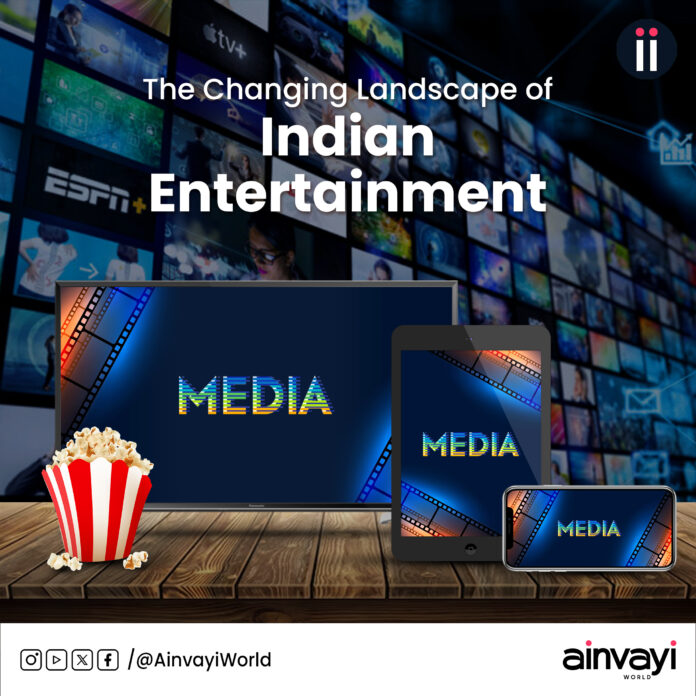The Indian entertainment industry has undergone remarkable transformations since its inception. What once revolved around the cinematic glamour of Bollywood and television soaps has now expanded into a vast universe of OTT platforms, short-form content, and interactive media. With faster internet and a multitude of devices, Indian audiences are redefining how they consume and engage with entertainment.
The Rise of OTT Platforms
The dominance of OTT (Over-the-Top) platforms is stronger than ever. Streaming giants like Netflix, Amazon Prime Video, and Disney+ Hotstar have become household names, while platforms like Zee5, Voot, Hulu, JioCinema, and SonyLIV have expanded their offerings, catering to increasingly diverse tastes and pushing the boundaries of Indian storytelling.
Unlike traditional cinema, OTT platforms bring storytelling directly into audiences’ homes, and unlike television, OTT platforms offer unprecedented flexibility. Viewers are no longer confined to scheduled programming, allowing them to watch what they want, when they want, and how they want. The era of appointment viewing is gradually fading, with binge-watching and re-watching becoming the norm.
The pandemic fast-tracked this transition, as movie halls shuttered, shoots halted, and people turned to home-based entertainment. What began as exclusive releases either in cinemas or on OTT platforms has now evolved into a time of hybrid releases, where films debut on OTT platforms within weeks of their theatrical run, further blurring the lines between cinematic and digital entertainment. High-profile films like Pathaan and Brahmāstra have leveraged these hybrid models, while smaller projects like Cinema Bandi found massive success on streaming, bypassing traditional theatrical releases altogether.
OTT platforms have also unlocked more creative freedom for artists and filmmakers. From thrillers like Sacred Games to thought-provoking films like Pagglait, the diverse array of stories on these platforms has gone beyond cinema’s typical masala fare, shaping the future of Indian content creation. Additionally, OTT platforms have exposed viewers to international content, with shows and films from countries like Korea and Turkey gaining popularity in India, enhancing cultural engagement.
Diverse Stories for a Diverse Audience
One of the most significant changes in the Indian entertainment landscape is the increased representation of regional and niche content. While the Hindi industry still has a strong hold, the rise of regional cinema on streaming platforms has allowed movies and shows in languages like Tamil, Telugu, Malayalam, Kannada, Punjabi, and Marathi to find a pan-Indian and global audience. Regional filmmakers are producing films and shows that break box-office records and garner global attention through streaming.
Moreover, there’s been a boom in original Indian web series, often exploring uncharted genres and bold storytelling. Shows like The Family Man, Gulmohar, Dhootha, and Sector 36 have resonated deeply with Indian audiences, offering narratives that go beyond conventional tropes. This democratization of content has allowed smaller voices and unique stories to shine.
AI-Driven Content
Recent months have also brought artificial intelligence (AI) into the entertainment equation. Streaming platforms now employ sophisticated AI algorithms to analyze viewers’ habits, tailoring content recommendations to individual preferences. From customizing film and show suggestions to curating interactive experiences through AR (Augmented Reality) and VR (Virtual Reality), platforms are shaping immersive experiences like never before. Some streaming services have even started offering AI-generated synopses, trailers, and personalized storylines, giving users a more interactive role in the content they consume. AI-based content creation is on the rise, with experiments in AI-generated scripts and short films gaining traction in the industry.
The Surge in Short-Form Content
Another latest trend is the surge in short-form content. Platforms like YouTube Shorts, Instagram Reels, and TikTok have capitalized on the demand for ‘snackable’ entertainment that fits into viewers’ busy lifestyles. Creators now produce high-quality, engaging content that can be consumed in under a minute, from comedy skits to educational videos. This rise in short-form content has also prompted traditional filmmakers to explore bite-sized storytelling. Some of the biggest Indian and regional directors are experimenting with mini-series and episodic formats that release in short bursts, allowing viewers to binge an entire season in one sitting.
The Strength of Regional and Hyperlocal Content
Indian entertainment is no longer restricted to major productions. Regional films and shows have continued to make massive strides, and thanks to OTT platforms, Tamil, Telugu, Malayalam, Marathi, Punjabi, and Kannada content is now more accessible to pan-Indian and global audiences. Stories like Ved, Jailer, RRR, and Pushpa: The Rise have set new benchmarks not just in their regions but across the nation and the world. Additionally, hyperlocal content is gaining prominence as platforms like Hoichoi (Bengali) and Aha (Telugu, Tamil) produce content that resonates with specific cultural and linguistic groups. This regional surge has led to a more decentralized entertainment ecosystem, where global platforms like Netflix curate hyperlocal stories that find international audiences.
The Big-Screen Experience Remains
Even with the dominance of digital platforms, cinema still holds its ground in today’s entertainment landscape. Theatres have re-emerged as cultural hubs, particularly for larger-than-life productions and franchise films. Movies like RRR, Jawan, Gadar 2, and KGF have drawn massive crowds back to theatres, offering the immersive visual spectacle that only the big screen can provide. Additionally, the trend of re-releasing classic films such as DDLJ, Rockstar, and Tumbbad has revived nostalgia and further attracted audiences back to cinemas, proving that some stories are still best experienced on the silver screen.
Cinemas have also adapted to the times by upgrading their experiences. From 4DX and IMAX technologies to luxurious seating and premium viewing services, from drive-in to open-air theatres, they are working hard to lure viewers from the comfort of their homes. Now, the theatre experience is as much about the atmosphere as it is about the film, giving audiences an escape they can’t replicate on their mobile devices.
Interactive Storytelling
One of the most exciting developments in recent times is the rise of interactive storytelling. Leveraging the capabilities of VR, AR, and gaming, Indian entertainment is moving into a realm where viewers can influence the narrative. Interactive shows and films are starting to allow users to choose alternate endings, engage in gamified plots, and even become characters in the story through VR. Indian creators are also experimenting with live, real-time interactive shows where viewers vote on the direction of the story as it unfolds. This fusion of entertainment and gaming is set to redefine how we engage with content, making the audience not just passive consumers but active participants.
Conclusion
As we stand in 2025, the Indian entertainment industry is at the zenith of transformation. The rise of OTT platforms, the convergence of media, AI-driven content personalization, and the emergence of interactive media are all playing pivotal roles in shaping the future of entertainment. While regional and hyperlocal stories gain international recognition, the cinema experience remains strong, drawing audiences with its unmatched grandeur.
This new landscape of Indian entertainment offers something for everyone, from short-form, snackable content to immersive interactive experiences. The availability of all content at all times has led to new cultural trends, including a rise in memes and discussions around both Indian and international films and shows, allowing viewers to compare Indian content with global standards. This scrutiny encourages filmmakers to put in extra effort to elevate their craft.
In this dynamic environment, entertainment transcends star-studded films and shows, focusing instead on stories that resonate across various platforms, languages, and formats. As technology progresses, the only certainty is that the world of Indian entertainment will continue to expand, providing a vibrant space for diverse and dynamic storytelling that captivates audiences globally.




